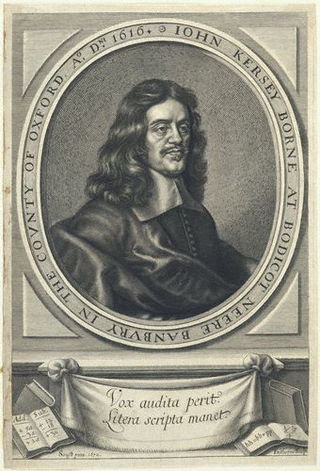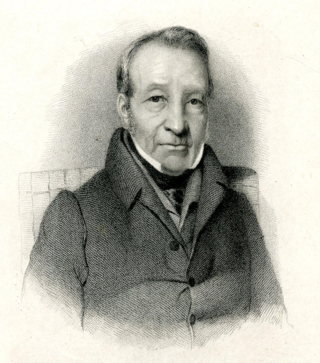
George Abbot was an English divine who was Archbishop of Canterbury from 1611 to 1633. He also served as the fourth Chancellor of the University of Dublin, from 1612 to 1633.

Flintlock is a general term for any firearm that uses a flint-striking ignition mechanism, the first of which appeared in Western Europe in the early 16th century. The term may also apply to a particular form of the mechanism itself, also known as the true flintlock, that was introduced in the early 17th century, and gradually replaced earlier firearm-ignition technologies, such as the matchlock, the wheellock, and the earlier flintlock mechanisms such as snaplock and snaphaunce.

"The whole nine yards" or "the full nine yards" is a colloquial American English phrase meaning "everything, the whole lot" or, when used as an adjective, "all the way", as in, "The Army came out and gave us the whole nine yards on how they use space systems." Its origin is unknown and has been described by Yale University librarian Fred R. Shapiro as "the most prominent etymological riddle of our time".

Sir Titus Salt, 1st Baronet, was a manufacturer, politician and philanthropist in Bradford, West Riding of Yorkshire, England, who is best known for having built Salt's Mill, a large textile mill, together with the attached village of Saltaire, West Yorkshire.

Buckram is a stiff cotton cloth with a plain, usually loose, weave, produced in various weights similar to muslin and other plain weave fabrics. For buckram, the fabric is soaked in a sizing agent such as wheat-starch paste, glue, or pyroxylin, then dried. When rewetted or warmed, it can be shaped to create durable firm fabric for book covers, hats, and elements of clothing.

Royston is a town and civil parish in the District of North Hertfordshire and county of Hertfordshire in England.

A spaniel is a type of gun dog. Spaniels were especially bred to flush game out of denser brush. By the late 17th century, spaniels had been specialized into water and land breeds. The extinct English Water Spaniel was used to retrieve water fowl shot down with arrows. Land spaniels were setting spaniels—those that crept forward and pointed their game, allowing hunters to ensnare them with nets, and springing spaniels—those that sprang pheasants and partridges for hunting with falcons, rabbits and smaller mammals such as rats and mice for hunting with greyhounds. During the 17th century, the role of the spaniel dramatically changed as Englishmen began hunting with flintlocks for wing shooting. Charles Goodall and Julia Gasow (1984) write that spaniels were "transformed from untrained, wild beaters, to smooth, polished gun dogs."

Gun dogs, or bird dogs, are types of hunting dogs developed to assist hunters in finding and retrieving game. The term hunting dog is broad and includes all breeds and skills of hunting canines, but "gun dogs" refers to canines that are trained to work alongside a loud firearm while hunting or retrieving game. Gun dogs are divided into three main categories: pointers and retrievers, setters and spaniels, and water dogs.

The Mikado pheasant is a gamebird in the pheasant family Phasianidae of the order Galliformes, gallinaceous birds. Sometimes considered an unofficial national bird of Taiwan, a pair of Mikado pheasants and Yushan National Park, one of the areas it is known to inhabit, is depicted in the 1000 dollar bill of the New Taiwan dollar.

A hunting blind (US), hide or machan is a concealment device or shelter for hunters or gamekeepers, designed to reduce the chance of detection by animals. There are different types of blinds for different situations, such as deer blinds and duck blinds. Some are exceedingly simple, while others are complex. The legality of various kinds of blinds may vary according to season, state and location.

"Who Killed Cock Robin" is an English nursery rhyme. It has a Roud Folk Song Index number of 494.
In fowl hunting, a cockshoot, also called cockshut or cock-road, was a broad glade, an opening in a forest, through which woodcock might shoot. During the day, woodcocks remain out of sight, unless disturbed; but at night, they take flight in search of water. Flying generally low, they will follow along any openings in the woods. Hunters would place nets across the glade to catch any such birds.

In the United Kingdom, the term hunting with no qualification generally refers to hunting with hounds, e.g. normally fox hunting, stag (deer) hunting, beagling, or minkhunting, whereas shooting is the shooting of game birds. What is called deer hunting elsewhere is deer stalking. According to the British Association for Shooting and Conservation (BASC) over a million people a year participate in shooting, including stalking, shooting, hunting, clay shooting and target shooting. Firearm ownership is regulated in the UK by licensing. Provisions exist for those without a Firearm or Shotgun certificate to shoot under the supervision of a certificate holder.

Herbert Ernest Balch MA FSA was an English archaeologist, naturalist, caver and geologist who explored the caves of the Mendip Hills and pioneered many of the techniques used by modern cavers. Born in Wells, he gained a scholarship to The Blue School before leaving school at the age of 14 to become a messenger for Wells Post Office.

The Fox Cub Bold is the fourth book of The Animals of Farthing Wood series. It was first published in 1983 and has since been included in a single book with Fox's Feud and in the "Omnibus" edition with Fox's Feud and In the Grip of Winter.

John Kersey the elder (1616–1677) was an English mathematician, as well as a textbook writer.

Chantecler is a verse play in four acts written by Edmond Rostand. The play is notable in that all the characters are farmyard animals including the main protagonist, a chanticleer, or rooster. The play centers on the theme of idealism and spiritual sincerity, as contrasted with cynicism and artificiality. Much of the play satirizes modernist artistic doctrines from Rostand's romanticist perspective.
Admiral Peter Aplin was an English admiral.

John Lawrence was an English writer on political and agricultural subjects and an early advocate of animal welfare and rights.

Thomas Thornton (1751/2–1823) was an English sportsman, known for his assiduity in hunting and other outdoor pursuits, and in betting.


















